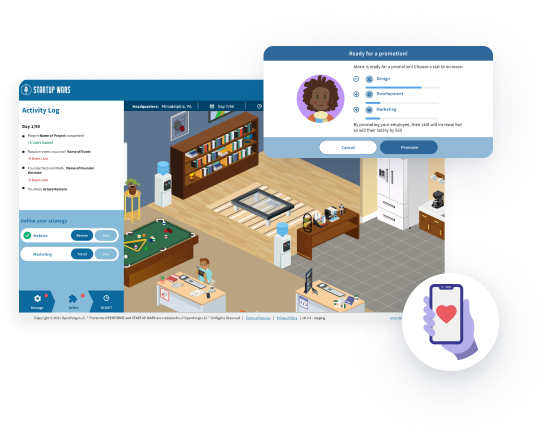Picture this: You’re at your computer, your heart racing as you make crucial decisions for your budding startup. Will your choice lead to success or a major setback? This is no ordinary classroom experience—it’s an entrepreneurship simulation, one of the most innovative tools transforming business education today. Simulations like this are changing the way students learn about entrepreneurship and making theory feel real.
In today’s fast-paced business environment, textbook knowledge alone isn’t enough. As the gap between classroom theory and real-world application widens, educators face a pressing challenge: how can we prepare students for the complexities of modern business?
The solution lies in entrepreneurship simulations or, better known as business simulations—interactive tools that offer hands-on, experiential learning. These modernized platforms follow teaching frameworks and techniques that allow students to apply theoretical concepts in real-world scenarios, providing them with invaluable practical experience.
In this post, we’ll explore the transformative role of these simulations in higher education, their benefits, and how they’re becoming a must-have in business curricula. Whether you’re an educator looking to revamp your teaching methods or a student eager to gain practical skills, this article will provide insights into the future of business learning.
Table of Contents
Why It's Time to Treat Business Education Differently
Entrepreneurship Education Needs Simulations
Traditional business education—relying on lectures, case studies, and exams—has dominated classrooms for decades. However, in today’s entrepreneurial world, theoretical learning alone doesn’t cut it. Graduates are expected to hit the ground running, making strategic decisions and navigating complex business environments from day one. This is where entrepreneurship simulations shine.
By using modern education techniques like simulation-based learning, students engage in real-time problem-solving, risk management, and decision-making within a controlled, low-stakes environment. These simulations mirror the real world by placing students in scenarios where they must think like entrepreneurs—without the financial risks of starting an actual business.
Higher Education Needs To Be More Than Theory
The beauty of entrepreneurship simulations is their ability to make abstract theories tangible. Students are no longer passive learners; they become active participants, applying what they’ve learned and experiencing the consequences of their decisions. The result? Students develop skills they’ll actually apply in their future careers.
What Are Business Simulations?
Entrepreneurship Simulation Games
At their core, entrepreneurship simulations are interactive tools that replicate the process of starting and running a business. These simulations are designed to reflect the dynamic nature of the real business world, allowing students to immerse themselves in the complexities of entrepreneurship, from managing finances to scaling a startup.
They can cover various aspects of running a business, such as:
- Managing resources
- Making strategic decisions
- Leading independent ventures
Common Types of Entrepreneurship Simulations
Here are a few common types of entrepreneurship simulations:
- Startup Simulations: Students create, manage, and grow a virtual startup, making strategic decisions on everything from product development to market expansion.
- Industry-Specific Simulations: These simulations focus on particular industries like healthcare, tech, or retail, providing students with industry-relevant challenges.
- Financial Simulations: Focused on the financial side of entrepreneurship, these simulations teach students about budgeting, capital management, and cash flow.
By participating in these simulations, students are tasked with solving real-world business problems. The simulated environment allows them to explore various strategies, adapt to market changes, and learn from their mistakes—skills that are essential in the entrepreneurial world.
The Power of Learning by Doing
Understanding Interactive Learning with Technology
We’ve all heard the saying, “You learn best by doing.” That’s exactly the premise of business simulations. Research shows that when students actively engage with the material—rather than just passively absorbing information—they retain more, understand concepts better, and develop critical skills faster.
Interactive Learning in Action
In entrepreneurship simulations, students aren’t just absorbing facts; they’re making decisions, solving problems, and seeing the outcomes of their choices unfold in real time. This form of interactive learning teaches far more than traditional methods ever could. It’s one thing to study a marketing plan in theory, but it’s another thing entirely to make marketing decisions that directly affect the success of a virtual company. The interactive element allows students to think critically and creatively, honing skills like problem-solving, strategic thinking, and adaptability—all key traits for future business leaders.
This approach does more than just sharpen skills. It gives students the confidence to take ownership of their learning and make decisions independently—exactly what’s needed in today’s fast-paced, ever-changing business world.
Key Ways Business Simulations Can Help In Your Class
Entrepreneurship simulations don’t just teach students; they transform them into active problem-solvers. Let’s look at how Business Simulations enable sustainable learning ways that change traditional business education:
Applying Real-Time Strategic Planning in a Business
In a typical classroom, students might learn about business strategies like market positioning or competitive analysis. In a business simulation, they’re asked to apply these strategies in real time, making decisions based on live data and shifting market conditions.
Simulation Example: In the T-Shirt Company Series, students might need to adjust their business strategy after a competitor releases a new product or a market shift impacts demand.

Hands-On Financial Management
Textbook theories on finance are essential, but there’s nothing quite like managing a budget under pressure. In financial simulations, students manage every dollar and cent, from tracking cash flow to making tough calls on resource allocation. They experience firsthand how financial missteps—like over-investing in one area—can sink a business, but they also see how strategic financial planning can lead to success.
Simulation Example: In the Food Truck Series, students manage budgets, price products, and track profitability while adapting to customer demand.

Fast-Paced Decision-Making
The world of business rarely allows time for lengthy deliberation. Decisions must be made quickly and confidently, often with incomplete information. Entrepreneurship simulations mimic these real-world pressures. Whether deciding on a product launch timeline or responding to an unexpected crisis, students develop the ability to think on their feet and make smart, fast decisions.
Simulation Example: In the Mobile App Series from Startup Wars, students are tasked with leading and scaling a SaaS startup, making decisions under tight deadlines and limited information, just like in the tech industry.

Fostering Independent Leadership and Healthy Competition
Startup Wars simulations take a unique approach by emphasizing individual decision-making and healthy competition, mirroring real-world business environments. Here’s how our simulations build essential skills:
- Independent Leadership: Students make crucial decisions on their own, fostering responsibility and confidence.
- Competitive Drive: A leaderboard motivates students to continuously improve their strategies.
- Adaptability: Changing conditions in the simulation cultivate quick thinking and flexibility.
- Self-Reflection: Instant feedback encourages continuous learning and improvement.
In the Makers Market Series, for example, students independently navigate various business challenges while competing for top spots on the leaderboard. This approach prepares them to trust their judgment, thrive under pressure, and strive for excellence – skills that are invaluable in any business career.
Preparing Students for the Workforce of the Future
- Strategic decision-making
- Financial management
- Adaptability to market changes Independent leadership
These core competencies are highly sought after by today’s employers. In fact, a recent survey of Fortune 500 companies revealed that 82% of employers value candidates with hands-on business experience, even at the entry-level.
The Startup Wars Advantage
Entrepreneurship Games: Merging Fun with Learning
Entrepreneurship games take learning to a whole new level by combining education with the excitement of competition. These gamified simulations aren’t just about running a business—they’re about winning at business.
The Role of Gamification in Business Education
Benefits in Startup Wars Simulations
- Real-world Complexity: Our simulations mirror the intricacies of actual business environments, challenging students to navigate multi-faceted scenarios.
- Immediate Feedback: Students see the results of their decisions in real-time, allowing for quick learning and strategy adjustment.
- Competitive Element: The leaderboard feature motivates students to continuously improve and benchmark their performance against peers.
- Industry-specific Challenges: With simulations ranging from T-Shirt Companies to Mobile Apps, students can explore various sectors and find their passion. Data-driven
- Decision Making: Students learn to analyze market trends, financial reports, and customer behavior to inform their strategies.
Best Practices for Integrating Business Simulations
Tips For Educational Programs
- Match Simulations with Course Goals: Choose simulations that complement your curriculum and support key learning outcomes.
- Provide Context: While simulations offer practical experience, pair them with relevant theoretical frameworks to deepen understanding.
- Encourage Reflection and Analysis: After each simulation round, facilitate discussions about decisions made, outcomes observed, and lessons learned.
- Use the Competitive Aspect: Leverage the leaderboard to spark healthy competition and motivate students to excel.
- Offer Support: While promoting independent decision-making, be available to clarify concepts and provide advice when needed.
Why Simulations Matter More Than Ever
Entrepreneurship Simulations Are Essential for New Generation's Career Success
Incorporating entrepreneurship simulations into the curriculum isn’t just about making education more engaging—it’s about preparing students for the real world. Research shows that employers value candidates with hands-on experience, especially those who can think critically, adapt quickly, and make data-driven decisions.
The demand for hands-on learning tools is on the rise, and educators are taking notice. In a 2024 survey, an impressive 92% of teachers reported that technology has had a positive impact on their student engagement (ZipDo, 2024). This trend is shaping the future of business education, ensuring graduates are not only knowledgeable but also skilled and ready to contribute from day one.
Simulations like Startup Wars offer exactly this type of training. Students leave these programs not just with knowledge, but with practical, applicable skills that set them apart in the job market. They learn to handle real-world complexities like managing a team, pivoting in response to market demands, and optimizing business strategies for long-term success.
Shaping Tomorrow's Business Leaders
From Learning to Leading
Including business simulations like Startup Wars in business school programs isn’t just a nice-to-have anymore—it’s a must. In today’s ever-changing business world, students need more than just book smarts. They need practical skills that will help them thrive in real-world situations.
By combining theory with practice through our simulations, business schools can prepare future leaders to:
- Navigate complex business situations with confidence
- Make smart, data-driven decisions
- Adapt quickly when markets shift
- Lead with independence and fresh ideas
Join Startup Wars to Elevate Your Business Course
Are you ready to shake up your curriculum? Bring Startup Wars simulations into your program today and give your students the edge they need to shine in the real world. Get in touch with us for a demo and see how our simulations can breathe new life into your business education approach.
Frequently Asked Questions
1.What is the biggest benefit of using entrepreneurship simulations in the classroom?
2. How do entrepreneurship games differ from traditional business simulations?
3. Why are entrepreneurship simulations important for modern education techniques?
4. How do I implement business simulations in my college curriculum?
5. What types of business challenges can students practice with Startup Wars simulations?
Let's Empower The Next Generation Of Founders
Schedule a call with our team to explore how Startup Wars can fit into your classroom.
Sources
- Hsu, C.-Y.; Wu, T.-T. Application of Business Simulation Games in Flipped Classrooms to Facilitate Student Engagement and Higher-Order Thinking Skills for Sustainable Learning Practices. Sustainability 2023, 15, 16867. https://doi.org/10.3390/su152416867
- Graduate Management Admission Council. (2023). Corporate recruiters survey report. https://www.gmac.com/-/media/files/gmac/research/employment-outlook/2023_gmac_corporaterecruiters_report.pdf
- Raymond James. (2023). Education technology quarterly. https://www.raymondjames.com/-/media/rj/dotcom/files/corporations-and-institutions/investment-banking/industry-insight/education-technology-quarterly.pdf
People Also Searched For:
-
Key Finance and Accounting Concepts Students Learn From Startup Wars
-
How Startup Wars Uses The Main Principles Of Lean Canvas Methodology
-
Financial Management and What Students Can Learn From A Startup Simulation Game
-
Tips To Be Successful In A Startup Simulation
-
How Startup Wars Allows Students To Make Critical Business Decisions





